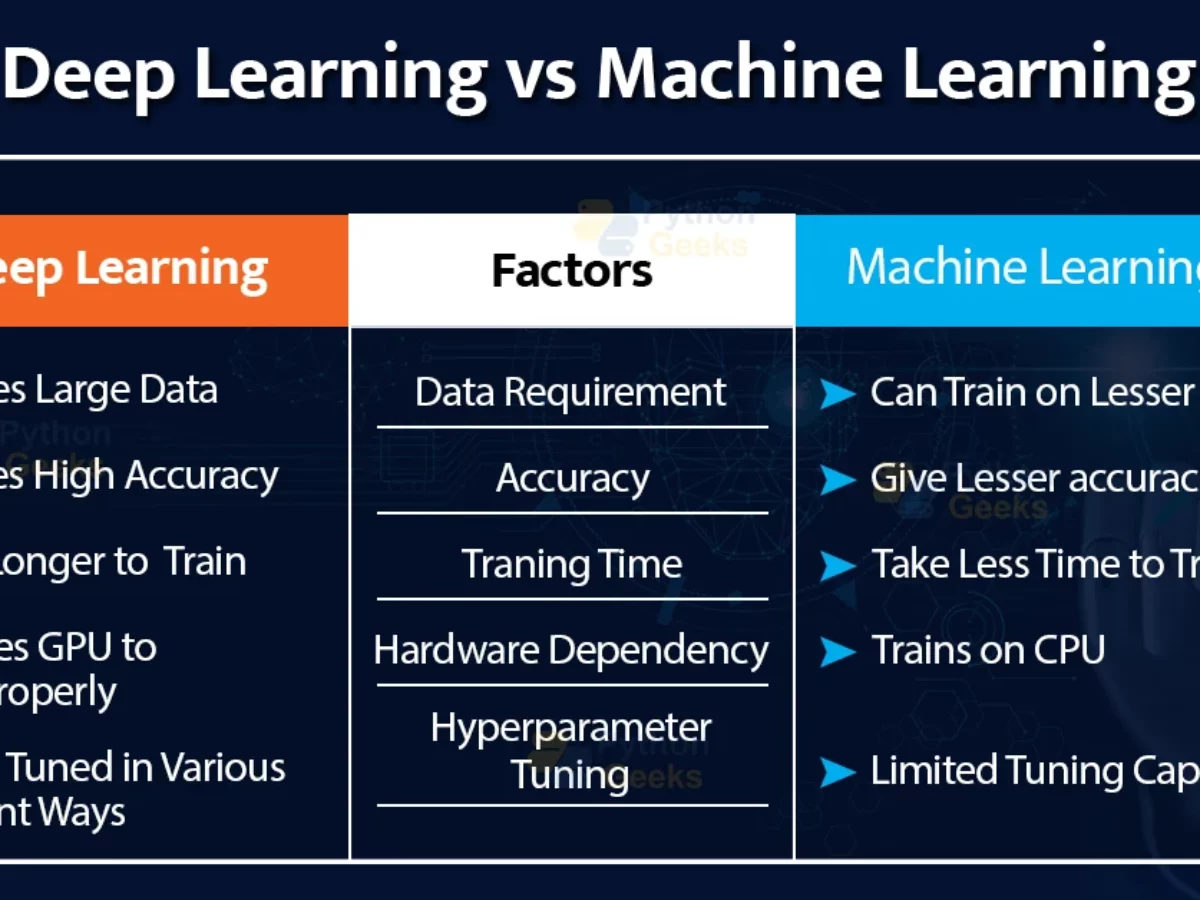Differences Between Machine Learning and Deep Learning: Concepts and Applications

Learn the differences between Machine Learning and Deep Learning, what they are, their applications, and how to choose the best option for your data.

Learn the differences between Machine Learning and Deep Learning, what they are, their applications, and how to choose the best option for your data.
Machine Learning is a branch of artificial intelligence that focuses on developing systems capable of learning from data. Machine learning algorithms enable machines to make decisions, solve problems, and take actions without being explicitly programmed for each task. (Source: GoDaddy)
On the other hand, Deep Learning is an advanced category of machine learning that uses a neural network architecture to learn from large volumes of data and draw conclusions for solving complex tasks. (Source: GoDaddy) Deep neural networks process information through multiple layers, a process that mimics the way the human brain operates.
Both concepts, Machine Learning and Deep Learning, are complementary and fall within the broader field of artificial intelligence, with Deep Learning representing an evolution of traditional Machine Learning. (Source: Zendesk)
Although both are related to artificial intelligence and automated learning, there are key differences between machine learning and deep learning:
Artificial Intelligence can be divided into three types:
Machine Learning and Deep Learning are subfields of Weak AI and are considered to be two of the most promising and effective approaches within this field in terms of practical capabilities and applications.
Machine Learning is already applied in various fields:
On the other hand, Deep Learning shines in areas such as:
These are just a few examples of how Machine Learning and Deep Learning are applied in today's world.
But remember, the choice between the two should be based on the specific problem that needs to be solved, the type and volume of your data, and the available computational resources.
The specific problem, the type and size of data, and your computational resources are all factors that will determine whether you should opt for Machine Learning or Deep Learning.
Based on these factors, here are some practical recommendations for different scenarios:
Understanding the differences between Machine Learning and Deep Learning is essential for harnessing the potential of artificial intelligence. Both Machine Learning and Deep Learning have their own strengths and areas of application, and your choice should be based on your specific problem, the type and volume of your data, and the resources available.
Although both are fundamental subfields of artificial intelligence, each has its place and offers diverse opportunities in the ever-evolving tech world. A solid understanding of these tools will enable you to make informed decisions and fully leverage the AI revolution. We encourage you to explore these fascinating areas of artificial intelligence in greater depth.
There is no one-size-fits-all answer to this question. Both Machine Learning and Deep Learning have their respective advantages. The choice depends on several factors, such as the volume of data, the nature of the problem, available computational resources, and the level of model complexity required.
No, Deep Learning will not replace Machine Learning. Although Deep Learning is a subset of Machine Learning and can perform some tasks with significantly higher accuracy, there are still many applications where Machine Learning is more suitable. In scenarios with limited data or when a clearer model interpretation is needed, Machine Learning has evident advantages.
Prior learning of Machine Learning can be very beneficial before diving into Deep Learning. This is because Machine Learning provides a solid foundation in the concepts of automated learning, which are then expanded and adapted in the field of Deep Learning.
Learning Machine Learning and Deep Learning can be challenging, especially if you are completely new to the world of artificial intelligence. You will need a solid foundation in mathematics, particularly statistics, linear algebra, and calculus, as well as programming skills. However, with study and practice, these fields can be mastered. There are numerous online resources and courses that can help you get started.
Machine Learning and Deep Learning have applications in numerous sectors. They are used in product recommendations, spam detection, voice and image recognition, sentiment analysis, medical diagnosis, stock market prediction, and much more.